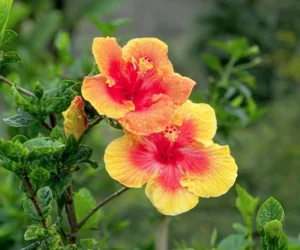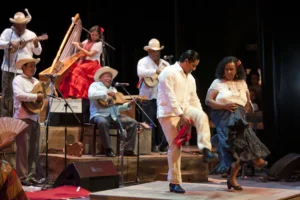
Culture

-
Huapango: The Rhythmic Soul of Mexico’s Musical Heritage
As Mexico continues to celebrate its rich tapestry of traditional music, the huapango stands out as a vibrant emblem of cultural fusion and artistic expression. Born from the mestizaje of Indigenous, European, and African influences, huapango is more than a genre—it’s a living tradition that pulses through the heart of the country’s musical identity. Originating […]
-
La Plata: A Planned, Cultural, and Lively City
Just over 50 kilometers from Buenos Aires lies La Plata, the capital of the province of the same name and one of Argentina’s most unique cities. Founded on November 19, 1882, by then-governor Dardo Rocha, La Plata was designed from the ground up as a planned city, with a geometric layout that still stands out […]
-
Venezuelan Chicha: A Sweet Legacy from the Shores of Paria to the Streets of Today
Long before it became a creamy street favorite served with cinnamon and condensed milk, chicha venezolana was already a cultural cornerstone—its earliest mention dating back to Christopher Columbus’s third voyage, when he arrived at the coast of Paria and was offered “wines of different colors” by the Indigenous peoples. Those “wines,” as later clarified by […]
-
Guangdong Museum Opens Botero Exhibition
The exhibition features more than 80 works by the Colombian artist, including sculptures, paintings, and drawings. On Thursday, the Guangdong Museum opened an exhibition dedicated to Colombian artist Fernando Botero, marking the return of his work to China for the first time since 2016. The show is part of an Asian tour that will also […]
-
Harbour Island’s Pink Sand Beach: A Blush-Tinted Paradise Born from the Sea
On the eastern edge of Harbour Island, where the Atlantic Ocean meets the shore in a gentle embrace, lies one of the Caribbean’s most surreal natural wonders: a three-mile stretch of soft, pink-tinted sand that has captivated travelers, scientists, and dreamers alike. Known simply as Pink Sand Beach, this Bahamian treasure has earned global acclaim, […]
-
Dance as Identity: A Journey Through Uruguay’s Traditional Dances
Montevideo — In Uruguay, dance is more than just a form of entertainment: it is a living expression of history, cultural diversity, and collective spirit. From the neighborhoods of Montevideo to the vast rural plains, the country’s traditional dances have withstood the test of time, constantly evolving while preserving their essence. RELATED: Cha-cha-chá: The Cuban […]
-
Cha-cha-chá: The Cuban Rhythm That Conquered the World
The cha-cha-chá is one of Cuba’s most representative musical genres and dances, as well as a hallmark of popular Latin American music. Its origin dates back to the late 1940s and is associated with violinist and composer Enrique Jorrín, a member of the Orquesta América. Seeking a simpler, clearer alternative to the danzón-mambo, Jorrín created […]
-
Calipso: The Pulse of Resistance and Rhythm Across Afro-Caribbean Culture
More than just festive music, calipso remains a living testimony of Afro-descendant creativity, resistance, and memory. With roots in the Caribbean’s colonial past, this genre—shaped by African rhythms and layered with political expression—has evolved into a voice for communities long silenced. Originating in Trinidad and Tobago, calipso became a tool of communication among enslaved African […]
-
In Taznakht, Moroccan Women Weave Identity and Resilience into Every Ouaouzguit Rug
In the sun-drenched town of Taznakht, nestled in southeastern Morocco near the Sirwa Mountains, the rhythmic clatter of wooden looms echoes a centuries-old tradition. Here, the Ouaouzguit rug is more than a decorative object—it is a living symbol of Amazigh identity, feminine expression, and cultural continuity. At the heart of this tradition is the Aguiness […]
-
A Sensory Journey through Essential Caribbean Ingredients
Below, discover the core ingredients that every Caribbean kitchen relies on—and the stories they tell. Foundation Staples: Rice, Yuca & Plantain These versatile carbohydrates form the backbone of countless dishes, providing both substance and cultural significance. From Sea to Plate: Fresh Fish & Seafood Surrounded by ocean, Caribbean islands celebrate the sea’s bounty in every […]
-
La Guaira: History, Nature, and Tourism Potential on Venezuela’s Coast
The city of La Guaira, capital of the state of the same name, stands out as one of the most versatile destinations on Venezuela’s central coast. Founded in 1589 by Diego de Osorio, this port city combines a rich historical legacy with striking natural landscapes, strengthening its appeal in both national and international tourism circuits. […]
-
The Rich Ecuadorian Gastronomy: A Journey Through Flavors and Traditions
Ecuador, a country located on the equator, is not only known for its biodiversity and stunning landscapes but also for its rich and varied gastronomy. Ecuadorian cuisine reflects the cultural and geographical diversity of the country, ranging from the Pacific coast to the Andes mountains, through the lush Amazon rainforest and the Galapagos Islands. Each […]
-
Fortresses of Havana: Guardians of a Colonial Legacy
The historic fortifications of La Habana, Cuba’s capital, continue to captivate visitors and scholars alike, standing as enduring symbols of the city’s strategic importance during the colonial era. Declared a UNESCO World Heritage Site in 1982, Havana’s military architecture forms one of the most extensive and best-preserved defensive systems in the Americas. Constructed between the […]
-
Nassau’s Pirate Legacy Revived as Bahamian Capital Embraces Its Past
Once a haven for pirates, rum runners, and maritime rebels, the Bahamian capital of Nassau is reclaiming its storied past as a hub of Caribbean piracy during the 17th and 18th centuries. Today, the city’s sun-drenched shores and colonial architecture serve as a living museum for history lovers and adventure seekers alike. Founded in 1670 […]

















